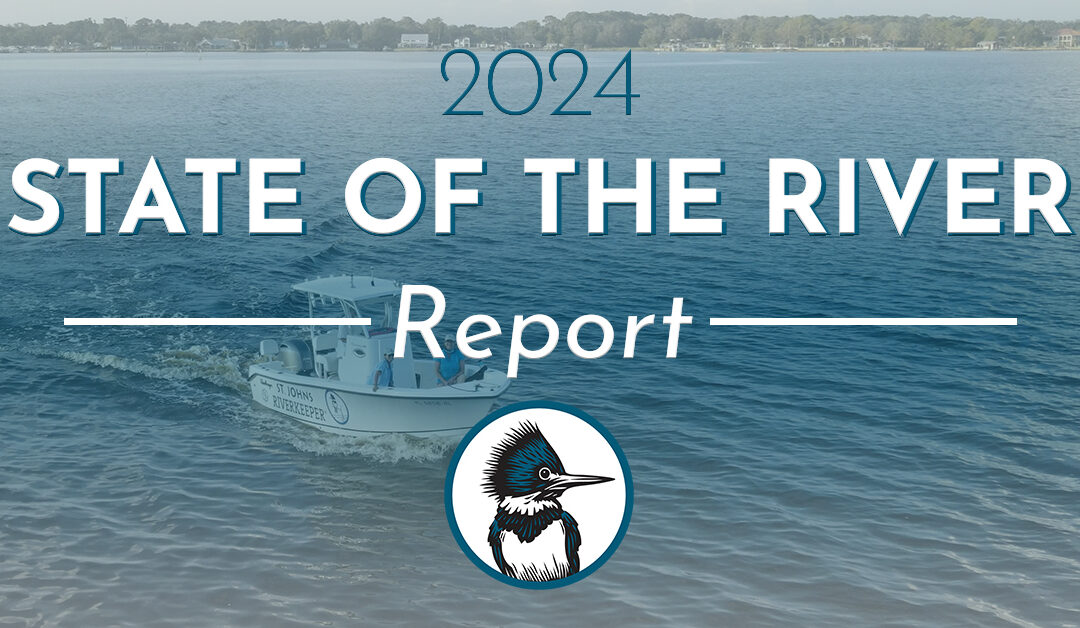The just-released 2024 State of the River Report for the Lower St. Johns River Basin (LSJRR) once again reveals significant reason for concern regarding the fragile health of our river and its tributaries. While a few of the river health indicators seem to be improving, increasing pollution, contamination and the impacts of rising waters and climate change are threatening our river, our health and our communities.
Funded by the Jacksonville Environmental Protection Board, The State of the River Report is produced annually by scientists and researchers from Jacksonville University, University of North Florida and Penn State Berks. The report evaluates the health of the Lower Basin by assessing the status and trends of various health indicators related to Aquatic Life, Contaminants, Fisheries, and Water Quality.
First for the relatively good news:
- Total nitrogen (TN) conditions in the mainstem of the Lower St. Johns remain “satisfactory.” However, TN data collection is insufficient and inconsistent.
- Dissolved oxygen (DO) continues to be satisfactory in the mainstem of the river, but the DO levels of the tributaries vary and regularly drop to concerning levels.
- The St. Johns’ blue crab and shrimp populations are doing fairly well. Wood stork and bald eagle populations, both dependent on the river, are listed as satisfactory with improving conditions.
Now for the persistent bad news:
- Chronically high fecal bacteria levels in our tributaries are an ongoing environmental and health concern. Forty-nine tributaries in the Lower St. Johns are impaired, 41 of which have confirmed sources of human sewage.
- Salinity levels continue to be unsatisfactory and increasing (“conditions worsening”) due to sea level rise and dredging activities.
- We continue to see a decline in wetlands and submerged aquatic vegetation (SAV) due to over-development, increases in salinity, higher water levels, pollution and other stressors.
- Toxic algal blooms continue to be a problem in the freshwater St. Johns’ mainstem.
- Total phosphorus (TP) levels in the tributaries and the marine section of the mainstem have risen over the last ten years.
- Sediment contaminants, such as PCBs, pesticides, metals and mercury, remain at unsatisfactory levels.
- Waterborne contaminants continue to be a problem, including pesticides, copper, cadmium, lead, nickel, silver, zinc and selenium in the tributaries, silver and selenium in freshwater section, and silver and copper in the estuarine section of the river.
Incremental improvements are simply not keeping up with the intensifying stress on our river from unsustainable growth, lackluster regulations and growing threats of the climate crisis.
Severely polluted tributaries throughout Duval County threaten human health with fecal bacteria, heavy metals and other contaminants. Rising water levels and increasing saltwater intrusion are changing our river’s ecology and threatening SAV as well as the fisheries that depend on them. Loss of wetlands due to development and inadequate mitigation are making Northeast Florida more vulnerable to flooding.
Our river needs us more than ever. We must work collaboratively throughout the watershed to tackle these threats and to restore the river we love for future generations.
Join us at Noon on Wednesday, October 23 for a Working “For the River” Lunch Webinar to further dig into the findings of the LSJRR and to roll up our sleeves to tackle these threats to restore the river we love.
Together, we must make a difference.
